European farmers fear unlimited poultry imports from Ukraine

Since the start of 2023, the European Union saw a surge in the import of broiler meat and eggs from Ukraine. This was made possible after the block lifted import quotas to support the war-torn country, but at the same time, the influx of poultry products sparked concerns among EU poultry producers.
In the first 8 weeks of the year, Ukraine exported 94% more broiler meat to the EU member states compared with the previous year. A total of 32,306 tonnes hit the EU internal market, the Association of Poultry Processors and Poultry Trade in the EU countries, or AVEC, estimated. The frozen broiler meat segment witnessed a stunning 171% growth to 16,663 tonnes, while in the chilled segment, volumes picked up by 40% to 12,439 tonnes.
The uptick in meat exports is almost overshadowed by the increase in egg exports. Ukraine managed to sell an impressive number of eggs to the EU member states. After the first 8 weeks of 2023, egg imports into the EU stood at 4,457 tonnes, which is 1,370% more compared with the previous year. This figure includes 3,317 tonnes of table eggs, up 2,570% compared with the first 8 weeks of 2022.
Exaggerated fears
The new statistical data sparked quite intense discussions between some European poultry business organisations about whether Ukrainian poultry exports pose a threat to the local market dynamics.
The Polish poultry meat promotion fund – a business union representing the interest of Polish farms – is confident that this is not the case.
“Ukrainian producers do not have to comply with the quality and animal welfare standards imposed on EU producers.”
“Some traders involved have been pondering the reality for several days. They state that the worries of poultry and egg producers about uncontrolled imports from Ukraine are exaggerated, and the quantities of imported poultry meat and eggs are not so large. Are these increases really small – as suggested by one of the organisations in interviews with some Polish media? I leave the assessment of these numbers to the readers,” stated Paweł Podstawka, chairman of the managing committee of the Poultry Meat Promotion Fund.
Soft welfare standards
The EU lifted quotas for meat and eggs from Ukraine in June 2022 to support the Ukrainian economy, which is suffering under the Russian invasion. Podstawka said that, as a result of this step, the poultry market of some European countries was flooded with cheap imported poultry meat and eggs.
“The problem is that Ukrainian producers do not have to comply with the quality and animal welfare standards imposed on EU producers. As a result, they can produce food much cheaper than we do,” said Podstawka.
Dariusz Goszczyński, president of the National Poultry Council-Chamber of Commerce in Poland, echoed these fears, adding that almost all broiler meat imports originate from one Ukrainian company, MHP.
“Since June 2022, 700 trucks loaded with meat have been entering the EU every month. Some of them went to the Netherlands, where this company has its plants and, after repackaging, the meat was spread around the EU at prices that were unattainable for us. As a result, we have chicken breast for PLN 13-14 (US$ 3.0 – 3.2) per kg in stores, when our producers can’t even think about profitability if the price is below PLN 19 (US$ 4.3),” he said.
 Beheer
Beheer











 WP Admin
WP Admin  Bewerk bericht
Bewerk bericht